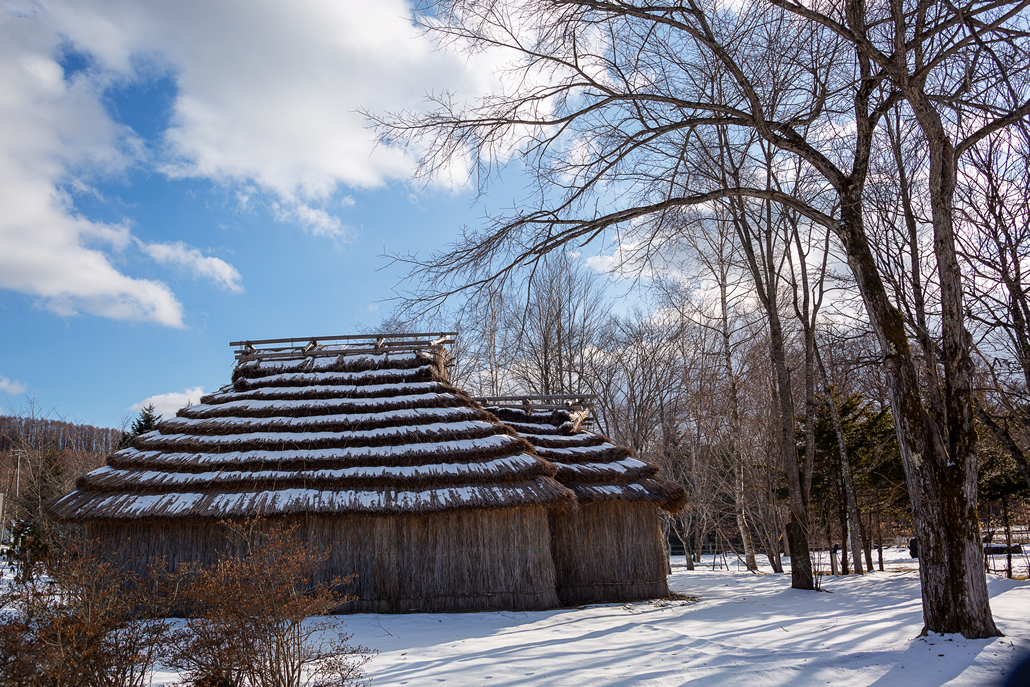
A group of cise built at Nibutani Kotan, where a traditional Ainu settlement has been recreated. The insides of the cise can also be viewed from May to October.

A group of cise built at Nibutani Kotan, where a traditional Ainu settlement has been recreated. The insides of the cise can also be viewed from May to October.
We were guided around the cise by Sekine Kenji of the Nibutani Ainu Culture Museum. As a specialist in the instruction of the Ainu language, he carefully explained aspects of the lifestyle that forms the background to the language.
Usually there was one poro cise (large cise) in each kotan; it was a special cise where the family of the head of the settlement lived and where people gathered for rituals. The interior is spacious with a high ceiling. There are two holes out of which the smoke is emitted; one window on the east side and two on the south side. The structure is almost the same as that of the cise in which normal families lived.
In the middle of the room is an open hearth, which formed the focal point of life around which the family ate, worked and conversed. Dried salmon and other preserved foods are hung above the fire.
There is usually one female on duty in the poro cise, who does craftwork while conversing with the visitors. Also, regular Ainu language events are held, and there are opportunities to listen to stories about Nibutani traditions and legends. In a separate poro cise, a broth containing lots of ingredients is wormed in an iron pot on the fire and, on some days, is offered to visitors.
According to Sekine, “When Ainu from other regions come to Nibutani, they are often surprised at and envious of the substantiality of the kotan. We all propose ideas and think about how we can make use of such excellent cise.”

In an old cise, fires were lit throughout the year, warming the ground so that it wasn’t too cold in winter.

White, donut-shaped preserved food. These are broken up and made into powder, which is used to make dumplings.

Gutted autumn salmon are slowly smoked above the fire

The window on the eastern wall is a sacred window through which the gods pass

In the alcove used to store precious items, in the eastern corner of the cise, are lacquerware and other items acquired from trading with the Wajin (Japanese).

Sekine Kenji
One of the characteristics of the Nibutani Kotan cise is the fact that each day, different traditional Ainu artisan come to create their crafts. Approximately 14 artisans carry out wood carving, embroidery and the like in two cise, and visitors there can watch them work. One of the artisans is Kaizawa Mamoru, who runs the Kaizawa Mingei craft shop opposite the Kotan.
“Demonstrations of the crafts have continued in the cise for almost 10 years. I’m usually there on Wednesdays. It’s a great opportunity for the visitors who come to Nibutani, to see our work.” Many of the beautiful works of art and crafts exhibited in the museum are those of Kaizawa and his colleagues; not “things from the distant past” but Ainu traditions that have been handed down and that are being worked on now on an everyday basis by the people who live here.

Kaizawa Mamoru. His current aim is to nurture young people into taking up traditional Ainu crafts.

Many of the materials include walnut and wood from the katsura tree. Walnut is liked due to the agreeable feel of the chisel when being carved.
Kaizawa Mingei 
Aza Nibutani 75-2, Biratori-cho, Saru-gun, Hokkaido, Japan
Tel.: 01457-2-2584
Hours: 8:00 to 18:00
Irregular holidays